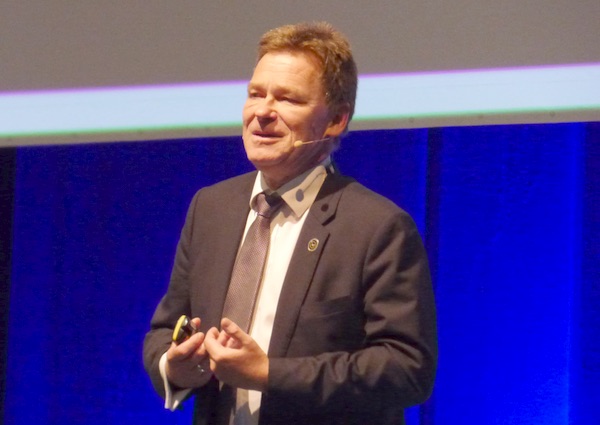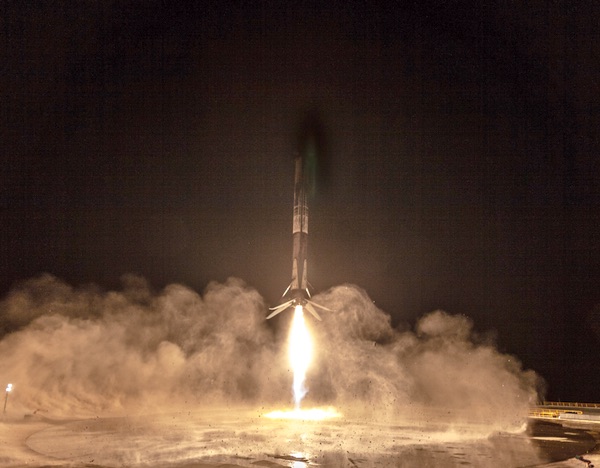Debating reusabilityby Jeff Foust
|
| “It’s not clear that reusability is the one and only solution,” Wörner concluded. |
While that launch was the first time a Falcon 9 first stage made a landing back at Vandenberg, the landing was otherwise part of an increasingly routine part of SpaceX’s operations. The company has now landed first stages 30 times, and reflown boosters more than a dozen times, including this launch: the Block 5 first stage that lifted off Sunday first flew in July, carrying a set of Iridium NEXT satellites.
From a technical standpoint, there seems to be little doubt that operational reusability—routinely recovering and reflying boosters—is feasible. But while others announce plans for reusability, like Blue Origin’s New Glenn, not everyone is convinced that reusability is always desirable.
“Reusability is fine from an ecological point of view. From an economic point of view, I don't know,” said Jan Wörner, director general of ESA, in a recent interview. He compared it to the production of water bottles: some are meant to be used over and over, while others are used only once and then recycled. “You even find bottles which are just destroyed,” he said.
“It’s not clear that reusability is the one and only solution,” he concluded. That conclusion, of course, reflects the current state of Europe’s launch vehicles: neither existing vehicles or ones under development, the Vega-C and Ariane 6, are designed to be reusable. However, ESA and European national agencies are investing in technology for future reusable vehicles. One example Wörner cited is Prometheus, a methane/liquid oxygen engine designed for low-cost production and multiple reuses.
The French and German space agencies are developing a reusable technology experimental vehicle called Callisto (for Cooperative Action leading to Launcher Innovation in Stage Toss back Operations) to test vertical takeoffs and landings, powered by a Prometheus engine. Models of Callisto, on display by those agencies in their exhibits at the International Astronautical Congress (IAC) in Bremen, Germany, made it look very much like a Falcon 9 first stage, complete with retractable landing legs and fins near the top.
Wörner, though, was skeptical that these would be sufficient. “But personally I’m not convinced that this is the one and only solution,” he said. “I believe we have to go into more disruptive solutions for launches in the future.”
And what does he mean by disruptive? “Any disruption is welcome. We are looking at winged bodies, we are looking into new propulsion systems, hybrid propulsion systems, air-breathing systems, and so on,” he responded. “So it’s really we are looking to all the different possibilities because it’s not clear what is most promising solution for the future.”
He added that the lower costs promised by reusability were not everything. “Ariane 5 itself is not one of the cheapest launchers, but reliability counts.”
| “You really want to maximize for some missions the mass you can put into deep space as opposed to using some of that mass to recover and return the vehicle,” Shannon said. |
Then there’s NASA’s Space Launch System, a vehicle that makes use of some of the core technologies demonstrated with the Space Shuttle program. In a decision galling to many space advocates, many of those technologies intended to make the shuttle reusable, notably the Space Shuttle Main Engine, or RS-25, won’t be reused on SLS. Engines that previously flew multiple times on shuttle missions, will be expended on initial flights of the SLS until a new variant of the RS-25 engine, intended for single-use missions, enters service.
In a call with reporters last week to update progress on the SLS core stage, John Shannon, vice president and program manager for SLS at Boeing, said the decision not to reuse engines or other components was based on performance.
“If you’re going to have a reusable vehicle, you have to take from the performance—the amount of hardware you can take up into space—you have to reduce that by the part of the mass required for propellant, for recovery systems, for anything you need to guide back to a landing,” he said.
That “makes a lot of sense,” he argued, for many missions, but not those being flown by SLS. “For going into deep space, though, the mass you can get is really at a premium.”
He cited as an example a new effort to improve the performance of the Exploration Upper Stage, which will be used on the later Block 1B version of SLS. With NASA’s decision earlier this year to delay the Block 1B’s introduction until the SLS’ fourth mission, versus its second, NASA has asked Boeing to find ways to increase the amount of additional “co-manifested” payload it can carry on missions to cislunar space. A lot of work is planned, he said, to get “one or two extra tons of co-manifest payload.”
“You really want to maximize for some missions the mass you can put into deep space as opposed to using some of that mass to recover and return the vehicle,” he concluded.
 Hans Koenigsmann, a SpaceX vice president, discussing the company’s work on reusable rockets during a talk at the International Astronautical Congress in Bremen, Germany, October 3. (credit: J. Foust) |
In defense of reusability
Defending the practice of launch vehicle reusability at last week’s IAC was Hans Koenigsmann, vice president of build and flight reliability at SpaceX. With Elon Musk staying home this year after giving famous—or infamous—keynotes at the previous two conferences, Koenigsmann was the main representative for the company at this year’s event.
Koenigsmann, though, was no stranger to Bremen—he worked at ZARM, the local microgravity research center, for several years prior to SpaceX—or IAC, or even IACs in Bremen. The last time the conference was held in the German city, 15 years ago, Koenigsmann was there along with others from the then-fledgling company to discuss development of the Falcon 1.
“Both Elon and Gwynne [Shotwell] were actually at the meeting here,” he recalled of the 2003 event. “We basically got no attention at all. We were just quietly around and looking at other people’s hardware.”
Times have changed, but the interest in reusability has not: even then, when the company was developing the Falcon 1, it was looking at ways to recover the first stage through parachutes. “Why reusability?” he asked. “Why are we so fixed, almost obsessed, with reusability?”
He said he couldn’t think of something in transportation that cost on the same order of a Falcon 9—$50 million— that was only used once. “I couldn’t find anything,” he concluded. “I don’t know of a high-value object that you use once, and then that’s pretty much it.”
The challenge, he acknowledged, is both technical, in terms of being able to land a first stage in the first place, but also financial, in that the recovery and reuse of that first stage needs to be less than a new rocket. “You’ve got to have the rocket recovered and reused with minimal refurbishment,” he said.
| “My job is reliability, and reliability benefits tremendously from reusability,” Koenigsmann said. |
Much of his talk dived into the details of how landing of Falcon 9 stages works, as well as their experience with the less visible part of reuse, the refurbishment of the boosters after landing. That includes inspections and checkouts of the booster, including static fire tests. “The majority of the work is on the engines, the thermal protection system, and the aero covers,” he said. “We have a long-term plan to reduce the refurbishment to routine inspections and periodic maintenance, but in order to do this we need to collect data, we need to collect experience.”
A lot of that experience has worked its way into the Block 5 version of the rocket, introduced earlier this year. The company has set a goal of flying each Block 5 booster a minimum of ten times with only minor refurbishment. The experience from the handful of Block 5 launches to date has been promising, he said.
“I’m surprised on how well the engines have held up,” he said. “At this point in time, I’m pretty happy. I think the rocket is really good.” He added, though, that the company was still working to “perfect” some of the hotter reentries.
While the Block 5 is intended for at least ten flights, no booster has flown more than twice so far, including Sunday night’s launch. However, Koenigsmann said after the talk that a Block 5 booster could make its third flight later this year, possibly on the SSO-A mission, a “dedicated rideshare” mission of dozens of smallsats planned for November from Vandenberg.
Reusability, he noted, offered benefits beyond lower costs. Being able to reuse first stages, he noted, enabled the company to sharply increase its launch rate: 17 launches so far this year, with several more on the manifest before the end of the year. “That is, for us, the enabling part on reusability,” he said.
It also has benefits for reliability, in terms of being able to inspect the vehicle. That is of specific interest to him given his job title of vice president of build and flight reliability. “My job is reliability, and reliability benefits tremendously from reusability,” he said.
In fact, he played down some of the economic benefits of reusability, at least in the ability of SpaceX in the near term to lower prices. “This didn’t happen overnight. We worked on this for many, many years. We put a lot of money in there,” he said. “And it’s our own money that we put in there.”
After the talk, he said the ability to lower prices will depend on how the company can recoup that investment. “At some point, I’m pretty sure they’ll come down. I hope it will come down, because that’s our goal,” he said of launch prices. “So we will drop them eventually, but I don’t know when it happens.”
Note: we are temporarily moderating all comments subcommitted to deal with a surge in spam.
